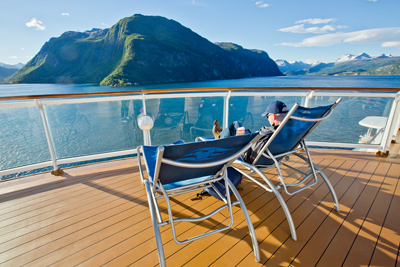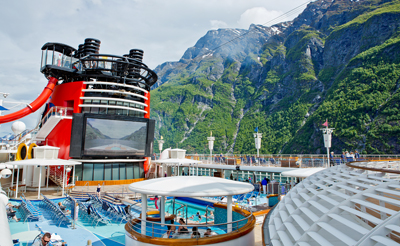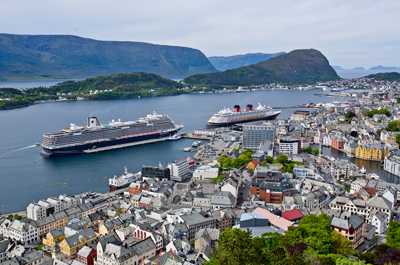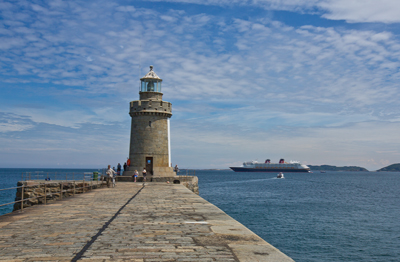
The 10 Most Important Things to Pack for Your Europe Cruise
Are you cruising to Europe with Disney Cruise Line this summer? It’s time to pack! While you’ll need many of the same kinds of things you need on cruises out of Florida, there are some extra things you should consider getting for traveling abroad. And here are ten of them!
 1. Passport – While you can get away without having a passport on cruises that start and end in the same U.S. city (assuming you have a suitable alternative government identification card and a state-issued birth certificate), you absolutely cannot get away without having it in Europe. (In fact, you won’t be able to get to Europe!) A passport card won’t work for cruising in Europe, you must have a passport. Our joke at home is that it’s the only thing you have to have. Everything else you can buy. You may end up with underwear with Mickey on it, but you can buy it! Pack your passport first, in your carry-on (or apply for one right now if you don’t have one).
1. Passport – While you can get away without having a passport on cruises that start and end in the same U.S. city (assuming you have a suitable alternative government identification card and a state-issued birth certificate), you absolutely cannot get away without having it in Europe. (In fact, you won’t be able to get to Europe!) A passport card won’t work for cruising in Europe, you must have a passport. Our joke at home is that it’s the only thing you have to have. Everything else you can buy. You may end up with underwear with Mickey on it, but you can buy it! Pack your passport first, in your carry-on (or apply for one right now if you don’t have one).
2. Power Converters/Adapters – The good news on a cruise is that you won’t need power converters/adapters on the cruise itself. The ships all have U.S. plugs. Where you will need an adapter (and possibly a converter depending on what your electrical device is) is in the hotels you stay at before or after your cruise. Some hotels (like one of my favorite hotels ever, the London Marriott Hotel County Hall), have a U.S. outlet or two, or even USB ports which are awesome, but don’t count on that being the norm. Bring a converter/adapter compatible for the countries you’ll be visiting.
 3. ATM and Credit Card – We’ve stopped exchanging currencies before we travel. You can pay big fees and it’s hard to know how much to get. My advice is to use your ATM card (at a bank ATM) as you travel. You’ll almost certainly find one right in the airport after landing. Get out what you need and keep getting it out as you need it. Otherwise, whenever possible, we use a credit card with a chip, and no foreign transaction fee. That gets us through without ever having too much cash left, and not paying exorbitant exchange rates. It’s very important to remember for both of these, call your bank and your credit card company and let them know you will be traveling. If your credit card requires a PIN code abroad, make sure you know it. One more thing – don’t let the stores charge you in USD. It sounds great, but they likely won’t use the best exchange rate. You’ll almost certainly pay more.
3. ATM and Credit Card – We’ve stopped exchanging currencies before we travel. You can pay big fees and it’s hard to know how much to get. My advice is to use your ATM card (at a bank ATM) as you travel. You’ll almost certainly find one right in the airport after landing. Get out what you need and keep getting it out as you need it. Otherwise, whenever possible, we use a credit card with a chip, and no foreign transaction fee. That gets us through without ever having too much cash left, and not paying exorbitant exchange rates. It’s very important to remember for both of these, call your bank and your credit card company and let them know you will be traveling. If your credit card requires a PIN code abroad, make sure you know it. One more thing – don’t let the stores charge you in USD. It sounds great, but they likely won’t use the best exchange rate. You’ll almost certainly pay more.
4. Travel Safe Bag – It’s almost possible not to look like a tourist in Europe, and being a tourist makes you a pickpocket target in some places. Invest in a good, slash-proof bag that locks. We’re big fans of PacSafe products. We bought one many years ago for our first Europe trip and have ended up using it on several trips, local and otherwise. Several of their backpacks have RFID-blocking material built into a pocket so you can store your credit cards and passport without fear of someone scanning the information inside.
 5. Sleep Aids – There’s a large time difference between the U.S. and anywhere in Europe. It may be hard to adjust. Flights across the pond are usually a red-eye of sorts. You’ll leave late afternoon or in the evening in the U.S. and land at your destination the next morning according to their time zone. The best plan for a quick adjustment is to get some sleep on the plane, then tough it out through the day after you arrive. You may need some help with that plan though. Bring a sleep mask and some kind of small pillow on the plane if you think it will help you. I sleep like a baby that first night in Europe after we arrive without anything but the exhaustion of the day to aid me. If you are someone that takes sleeping medication, bring that for the plane or your first night abroad.
5. Sleep Aids – There’s a large time difference between the U.S. and anywhere in Europe. It may be hard to adjust. Flights across the pond are usually a red-eye of sorts. You’ll leave late afternoon or in the evening in the U.S. and land at your destination the next morning according to their time zone. The best plan for a quick adjustment is to get some sleep on the plane, then tough it out through the day after you arrive. You may need some help with that plan though. Bring a sleep mask and some kind of small pillow on the plane if you think it will help you. I sleep like a baby that first night in Europe after we arrive without anything but the exhaustion of the day to aid me. If you are someone that takes sleeping medication, bring that for the plane or your first night abroad.
6. Scarf and or Skirt – Some locations you will visit have strict rules about how much skin you can show. The Vatican, for example, requests that visitors cover their knees and shoulders. Many churches follow the same rules. Since it can be crazy hot in Rome in the summer, and you may be wearing shorts or sleeveless shirts, consider packing a skirt in your bag to throw on over your shorts. A light scarf can be used to cover your shoulders. For men, pants that convert to shorts by zipping off the bottom of the legs, work great as well.
 7. Subdued Color Clothes – In an effort to blend in a little more, you may consider bringing clothes with more subdued colors. While you’ll certainly see locals in bright colors, most tend towards more muted colors. Of course if you know you’re going to stick out anyway, like me with my giant DSLR, wear whatever color you like! As long as your clothing isn’t culturally offensive, you’re good.
7. Subdued Color Clothes – In an effort to blend in a little more, you may consider bringing clothes with more subdued colors. While you’ll certainly see locals in bright colors, most tend towards more muted colors. Of course if you know you’re going to stick out anyway, like me with my giant DSLR, wear whatever color you like! As long as your clothing isn’t culturally offensive, you’re good.
8. Mobile Hotspot – Some phone companies have short-term international plans that work well for brief overseas trips. I’m a fan of AT&T’s International Day Pass. For $10 a day in most countries, your stateside plan and all of its features work in Europe. It’s great for temporary traveling and if you only need one or two phones working. If, however, you have several people in your family that would like Wi-Fi access, you may consider renting a mobile hotspot like Tep. Tep easily fits in a pocket of your backpack and will connect up to five devices at once. You can rent one for less than $10 a day and have it mailed to your home before you leave, or pick it up and drop it off in many major airports like Heathrow. Neither the mobile hotspots nor international plans will work at sea (unless you happen to be in range of the local cell phone service near the shore), so you’re still at the mercy of Disney’s plans and pricing onboard.
 9. Important Apps – I talked about some good apps to use while cruising in Europe in a previous blog post, but here’s a refresher. If you’re going to be relying on Wi-Fi instead of an international plan for your phone, download the Skype App. It’s a convenient, cheap way to make phone calls should you need to while traveling. If you are going it on your own for excursions, I recommend CityMaps2Go to get around. It’s a versatile app and easy to follow once you know where you’re going. Public transportation in Europe is easy to use if you have an idea of what you are doing, and having apps like the Tube app for London or Metro app for Paris will seamlessly figure out the best train routes to take in no time. Rick Steves also has an app, linking you to useful information on his website and providing tons of self-guided walking tours for locations across Europe. Finally, google the cities you are traveling to, and see what apps are recommended to help you travel there.
9. Important Apps – I talked about some good apps to use while cruising in Europe in a previous blog post, but here’s a refresher. If you’re going to be relying on Wi-Fi instead of an international plan for your phone, download the Skype App. It’s a convenient, cheap way to make phone calls should you need to while traveling. If you are going it on your own for excursions, I recommend CityMaps2Go to get around. It’s a versatile app and easy to follow once you know where you’re going. Public transportation in Europe is easy to use if you have an idea of what you are doing, and having apps like the Tube app for London or Metro app for Paris will seamlessly figure out the best train routes to take in no time. Rick Steves also has an app, linking you to useful information on his website and providing tons of self-guided walking tours for locations across Europe. Finally, google the cities you are traveling to, and see what apps are recommended to help you travel there.
10. Guidebook – I’m an enthusiastic fan of guidebooks both for planning and for actual use while traveling. After packing your Unofficial Guide to Disney Cruise Line, google the city you are traveling to and see what guidebooks you can find that are relevant. If you don’t want to carry the book around with you during the day, use your smartphone to take pictures of the relevant pages you will need. We took several pictures of pages in our Rick Steves book for Paris, and we were able to reference it without having the added weight in our daypack. You also could just download the electronic version of the next guidebook you buy if you want to save the weight of packing a book.
It may seem counter-intuitive to say this after I just gave you a list of things to bring, but pack light! Europeans travel light, and if you are doing any train travel at all you will thank me. You don’t want to be dragging giant suitcases through turnstiles and onto trains (and many of the train/metro stations we’ve been in don’t have accessible options). Take a good hard look at how many different outfits you think you need and reduce it. You can do laundry on board!
Is there anything else I’ve forgotten you think would be helpful? Let us know!
Tammy Whiting is the owner of Storybook Destinations. Did you know Storybook Destinations offers a complimentary subscription to TouringPlans with qualified Disney and Universal bookings? Click here for a no-obligation quote on your next vacation.




